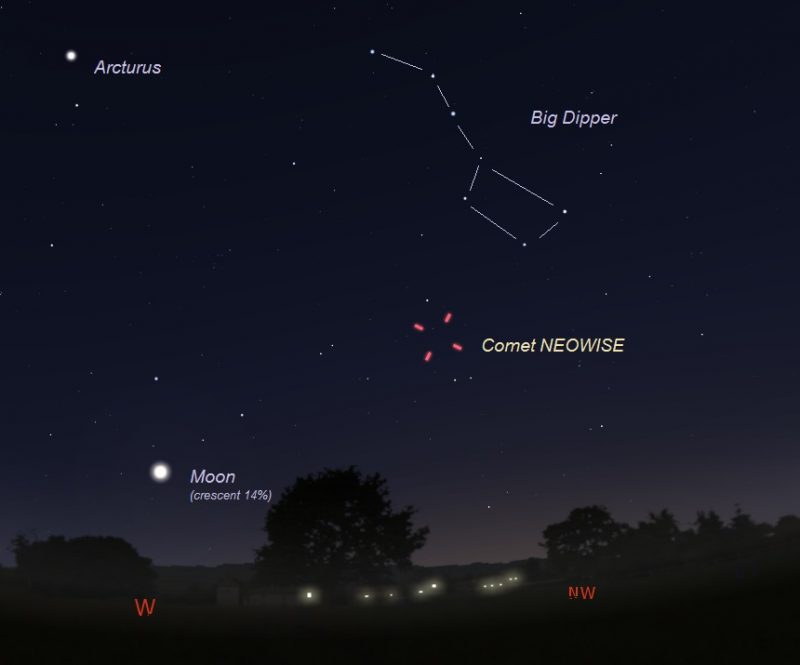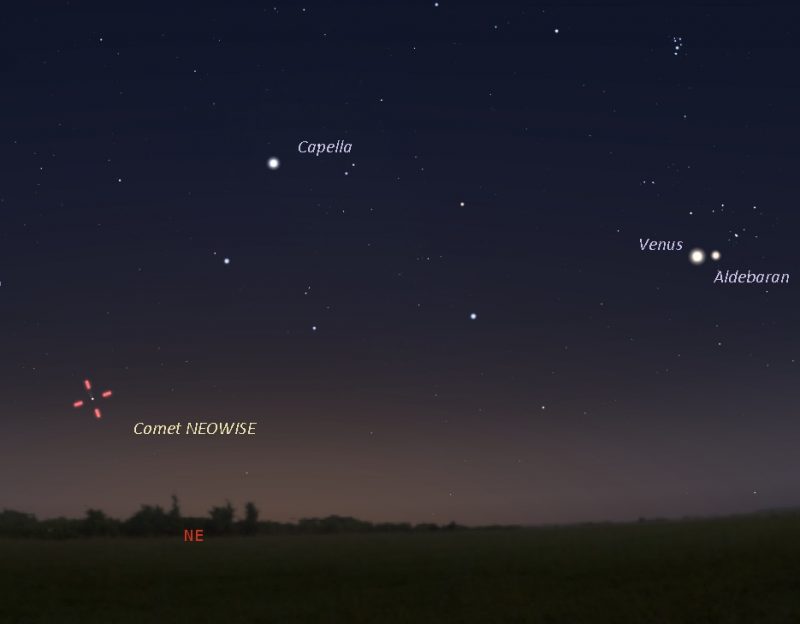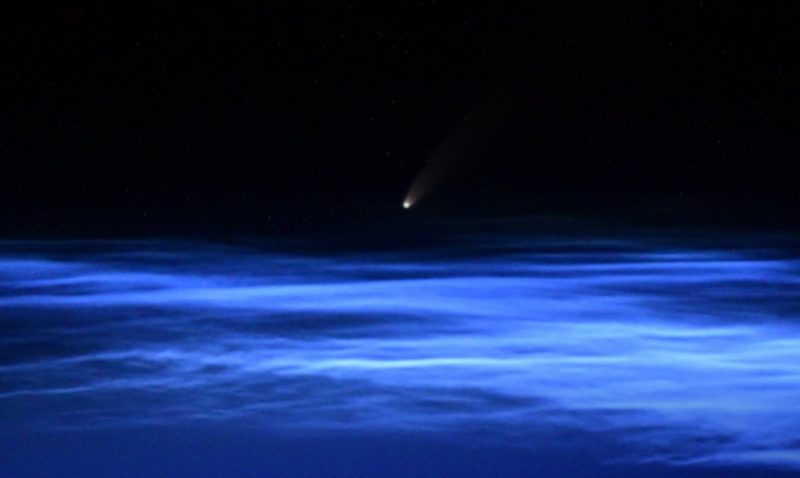How to see Comet NEOWISE | Space

Location of Comet NEOWISE just after sunset from July 13 to 19. Face northwest at dusk, avoiding trees or buildings to have a clear view of the northwest horizon. Sweep with your binoculars around the location for the comet marked on this chart. Observers at lower latitudes will see Comet NEOWISE lower in the sky, while it will appear higher for observers farther north. This comet is not visible from the Southern Hemisphere. For a specific view – on a specific date – from your exact location on the globe, try dialing this same scene – northwest, shortly after sunset – into Stellarium-Web. Opportunities for evening viewing will be improving in the days ahead. Illustration by Eddie Irizarry using Stellarium.
We still have to wait for another very bright comet, what astronomers call a great comet. But a wonderful binocular comet has been gracing our early morning skies, and now it’s visible in the evening as well, for observers at northerly latitudes such as those in the northern U.S. and Canada. Later this month, the comet will become visible in the evening for those at latitudes like those further south in the U.S. Sorry, Southern Hemisphere observers, this comet isn’t visible to you. Many observers have reported that – once you spot it with binoculars – you can remove them and glimpse this comet as a fuzzy object, using only the unaided eye. Using binoculars or other optical aid is a must, though, if you want to see this comet’s splendid split tail. The comet is called C/2020 F3 (NEOWISE). If it remains at its current brightness, it might be even easier to spot in the evening during the second half of July than it has been in the morning sky so far. The comet will be gradually higher each night, just below the Big Dipper, as seen in the evening charts, above and below.
Check the bottom of this post for a few photos, but – for many, many glorious shots of the comet from people throughout the Northern Hemisphere – visit EarthSky Community Photos. Thank you to all who have submitted photos!
Submit your own photo of Comet NEOWISE here.
Be sure to bring along binoculars if you want to see Comet NEOWISE. If you don’t have binocs but do have a good camera, a great alternative is to capture a few seconds long exposure image of the approximate area of the sky. Try at different magnification or zoom settings, and the results should reveal the comet’s nice tail.
Comet NEOWISE will be closest to Earth on July 22-23, 2020. It will pass at some 64 million miles (103 million km) from our planet. The good news is that – if the comet continues looking great – the view during the night of closest approach should be nice for many of us at temperate latitudes in the Northern Hemisphere. Although binoculars are required for the celestial visitor, it will be visible at the same time we see a beautiful crescent (not too bright) moon.

Location of Comet NEOWISE on the night of closest approach to Earth – July 23, 2020 – as seen from the central U.S., facing west-northwest just after sunset. Illustration by Eddie Irizarry using Stellarium.

View at EarthSky Community Photos. | The wonderful binocular comet that’s been gracing our early morning skies – Comet NEOWISE – is now also visible in the evening, with optical aid, for latitudes like those in the northern U.S. and Canada. James Younger captured this image of NEOWISE and an aurora (the green glow on the right in this photo) on July 14, in the evening, from Vancouver Island in British Columbia, Canada. Thank you, James!
Want a morning chart? The comet is becoming harder to see in the morning now. Try going outside about an hour before sunrise, and don’t just look once … look as the minutes tick by for the comet to rise high enough into the dawn sky for you to spot it. There’s a very narrow window for spotting it, when it’s still dark enough in the sky to see the comet, but when the comet has risen high enough above your horizon to be visible. Again, observers at northerly latitudes will have the best view. The chart below was for around mid-July (July 13 specifically, but it’ll work for a week or so after that date, too):

Location of Comet NEOWISE just before dawn on or around July 13, as seen from central U.S., facing northeast about 45 to 60 minutes before sunrise. As the days progress forward from July 13, look for the comet to the north (left) of the location marked on this chart. Venus is the very bright planet, near the bright star Aldebaran now. while Capella is a bright star seen toward the northeast now at dawn. For a specific view – on a specific date, from your exact location on the globe, try dialing this same scene – northeast, shortly before sunrise – into Stellarium-Web. Illustration by Eddie Irizarry using Stellarium.
Let’s look at some more photos! And be sure to check out EarthSky Community Photos for still more. We are receiving many, many images of the comet each day.

A wonderful binocular comet has been gracing our early morning skies, and now it’s visible in the evening as well, with optical aid. At present, it’s best seen from latitudes like those in the northern U.S. and Canada, but the comet will be becoming easier to see as the weeks pass. The comet is called C/2020 F3 (NEOWISE). This image is from Bob King – aka AstroBob – in Duluth, Minnesota. He wrote: “My first view of Comet NEOWISE at dusk instead of dawn from a lake near Duluth on July 11. Comets and water naturally go together as they’re thought responsible in part for delivering water to the early Earth.” Thank you, Bob!

View at EarthSky Community Photos. | Gianluca Masi of the Virtual Telescope Project captured Comet NEOWISE on July 7, 2020, along with the International Space Station (dashed line), in this dawn view of Rome, Italy. “What a sight!” he wrote.

View at EarthSky Community Photos. | Composite image of Comet C/2020 F3 (NEOWISE) captured by Marsha Kirschbaum in San Leandro, California, on the morning of July 5, 2020. She wrote: “It was a really early a.m. wakeup call for me. This icy celestial visitor survived its pass by the sun to put on a splendid show at 4:45 a.m. this morning. After a night and early morning of the dull background roar of fireworks punctuated by really loud ‘bombs’ with the smell of smoke, I was really doubtful I would see the comet because of the haze. And there was a lot of it as can be seen on the horizon in this image. I couldn’t quite see it with the unaided eye, but my 200 mm lens saw it just fine. My kind of celestial fireworks.” Thank you, Marsha!

View at EarthSky Community Photos. | Alexander Krivenyshev in Guttenberg, New Jersey – of the website WorldTimeZone.com – wrote: “Despite a layer of clouds on the horizon, I was able to capture my first comet over New York City on the early morning of July 6, 2020.” Cool shot, Alexander! Thank you.

This image – taken on the morning of July 5, 2020, by Jeremy Perez at Sunset Crater in Arizona – shows comet C/2020 F3 (NEOWISE) on the same scale that you might see it with the eye alone. Try to use binoculars to reveal all the beauty of this comet. Used with permission. Thank you, Jeremy!

Another July 5 shot of comet C/2020 F3 (NEOWISE) by Jeremy Perez in Arizona. This one is more of a close-up. “It was an easy naked-eye object,” wrote this experienced sky observer, who was looking in a desert sky, “but really rewarding through binoculars.” Used with permission. Thanks again, Jeremy!
Comet NEOWISE has even been seen from the International Space Station!
Comet NEOWISE from ISS, July 5th pic.twitter.com/pAbGdtchAc
— Seán Doran (@_TheSeaning) July 7, 2020
Russian cosmonaut Ivan Vagner says the comet’s tail is clearly visible from the space laboratory’s cupola. Look at this amazing image:

Comet C/2020 F3 (NEOWISE) and noctilucent clouds captured from the International Space Station. Image via Roscosmos.
Alessandro Marchini of the Osservatorio Astronomico Università di Siena posted these photos to Facebook:
Here is another great image by Philipp Salzgeber from Austria:
Comet C/2020 F3 Neowise image taken with 300mm lens, f/5.6, Nikon Z6, 0,4s, ISO 1600 from Wolfurt / Austria. The comet was clearly visible with the unaided eye, it was beautiful in the 10×50 binoculars. #comet #neowise pic.twitter.com/hBGeJZKtie
— Philipp Salzgeber (@astro_graph) July 5, 2020
Niccole Neely posted this photo and said, “Here is another shot of #CometNeowise…this time a bit closer! Look at that beautiful tail! Taken in Arizona this morning!”
When was NEOWISE first discovered? Comet C/2020 F3 (NEOWISE) was discovered on March 27, 2020 – not from Earth’s surface – but from by a space observatory some 326 miles (525 km) above Earth’s surface. It’s named for its discoverer, the Near Earth Object Wide-field Infrared Survey Explorer, aka NEOWISE, which was launched by NASA in 2009.
Comet NEOWISE was closest to the sun on July 3, 2020, passing at about 26.7 million miles (43 million km) from the sun, or a bit closer than the average distance from the sun to Mercury. Unlike some comets, it survived the close encounter with our star and went on to become widely seen by binocular observers and astrophotographers.
How big is Comet NEOWISE? Joseph Masiero, NEOWISE deputy principal investigator at NASA’s Jet Propulsion Laboratory, commented recently:
From its infrared signature, we can tell (its nucleus) is about 3 miles (5 km) across … and is covered with sooty, dark particles left over from its formation near the birth of our solar system 4.6 billion years ago.
In other words … a typical comet!
How bright is Comet NEOWISE? In early July, reports began indicating that Comet NEOWISE has a visual magnitude between 1 and 2. If you know the magnitude scale, where smaller numbers indicate brighter objects, that may sound very bright! However, stars are pinpoints of light, whereas the light of comets is diffuse (spread out). So, for comets, a magnitude of 1 or 2 is fainter than it would be for a star of equal magnitude. The reason is, the comet’s light is distributed over a relatively wide area, instead being concentrated in a single point.
Is Comet NEOWISE a great comet? There’s no strict definition for great comet, but most agree that Hale-Bopp – widely seen by people in 1997 – was one. NEOWISE is nowhere near as bright as Hale-Bopp was. Unlike Hale-Bopp, NEOWISE will never be easily visible to the eye. So it’s not a great comet. But it’s a beautiful binocular comet, absolutely the best comet we’ve had for casual observers in some time.
Don’t miss it.
And, by the way, forget about making plans to view this comet’s next apparition in Earth’s skies. Comet NEOWISE might be visible again from Earth, but not until around the year 8,786!
#Komet C/2020 F3 #NEOWISE und #NLC s über der #Isar und dem #Hinterbrühler See (#München)
Ein wundervolles #Naturschauspiel! pic.twitter.com/0IHjs73RHm
— Astronomie München (@munichspace) July 10, 2020
Long exposure images show even more details:
Cosmic Eruption – Comet NEOWISE looking incredible from Joshua Tree National Park @jackfusco pic.twitter.com/pAwdP6eh9P
— earth is beautiful (@earth__photos) July 12, 2020
Bottom line: Comet C/2020 F3 (NEOWISE) is basically a binocular object, although some experienced observers with pristine skies are reporting they can see it with the eye alone. Around July 12-15, the comet began to appear in the evening sky as well as the morning sky. This post has information and charts that will help you see the comet.


Twitter fan. Beer specialist. Entrepreneur. General pop culture nerd. Music trailblazer. Problem solver. Bacon evangelist. Foodaholic.





